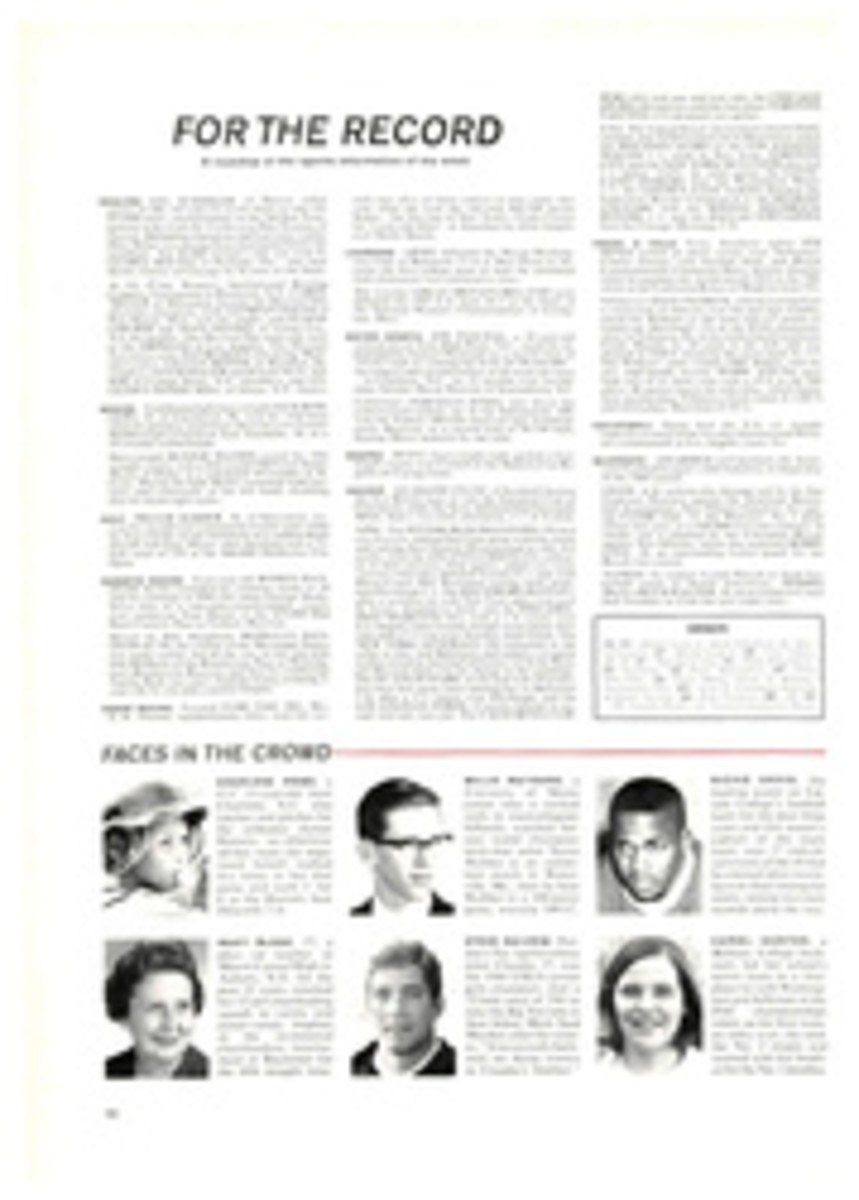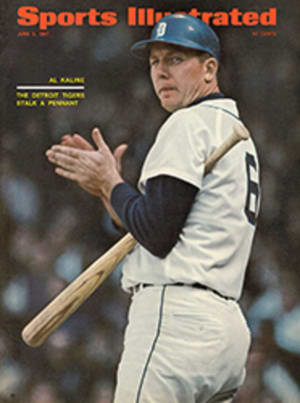
A BLOW FOR ESTHETICS
Never in the 70 years that the Royal and Ancient Golf Club of St. Andrews and the United States Golf Association have been the guardians of golf's traditions and the arbiters of the sport's rules, equipment, ethics and etiquette have the two organizations made quite so bold a stroke as they did last week. Backing up their decision with words like "appalled" and "travesty of the game" and "aberrations," the USGA and the R&A outlawed the increasingly popular croquet style of putting, and all kinds of unusual putters as well. To millions of hands that quake over four-footers, this blow for esthetics felt like a karate chop.
The ruling, which takes effect in January 1968, was a venture into new territory, for always in the past the USGA's and the R&A's concern for good form has been a concern for good manners, not for the technical execution of the swing. Now, for the first time in golfing history, the game's ruling bodies were telling a man how he had to hit the ball. The essence of the rule is that not only does a golfer have to try to sink a putt, he has to look good doing it.
"We made the decision with great reluctance," says USGA Executive Director Joseph C. Dey, "but we felt it was the only way to eliminate the unconventional styles that have developed in putting. The game of golf was becoming bizarre. It was some other game, part croquet, part shuffleboard and part the posture of Mohammedan prayer."
Variations of the croquet style are used by Sam Snead—the most notorious of the Mohammedans—Touring Pros Bob Duden and Dean Refram, USGA President Ward Foshay, two former captains of St. Andrews and countless amateurs who have taken to it, instead of drink, to cure their putting wobbles. Snead, who shot a 64 on his 55th birthday last weekend while using his stooping croquet technique, says, "I putt better this cockeyed way. Not too many people can bend over quite as well as I can, but I think it is good for old golfers. They don't have to coordinate two hands, only one."
Dean Refram began putting the croquet way when a doctor told him his eyes did not focus along the same line. Standing astride the ball, he found he could sight his putts better.
But Joe Dey contends that the success of the technique in steadying nerves or curing optical ills does not justify its use. "Should you make allowances in a sport for physical peculiarities or infirmities?" he asks rhetorically. "I think not. The way golf clubs were originally made, with the shaft attached to the heel, indicates that the game was always meant to be played from one side or the other."
There is nothing new about facing the problem of putting head on. A player showed up at the first U.S. Amateur Championship in Newport, R.I. in 1895 with a billiard cue which he used for a putter. Soon thereafter the USGA scratched that idea, ruling that the cue did not conform to golf equipment standards. In 1904, however, the British made the mistake of allowing three-time U.S. Amateur Champion Walter J. Travis to use an unorthodox center-shafted putter in their Amateur tournament. Travis won the tournament. The British had hardly handed Travis his trophy before they banned his club and all similar travesties. But the USGA, perhaps influenced by the fact that an American had finally been able to win a British championship, began allowing some deviations from the traditional design of putters. Finally in 1951 the Royal and Ancient and the USGA met to standardize the Rules of Golf, and the British agreed to allow the use of USGA-approved putters.
Today there are innumerable different types of putters registered with the patent office in Washington, and hundreds of them have USGA approval. But many certified models, including the croquet-style putter, will now be outlawed. Among the stipulations announced last week by the USGA and the R&A, for example, is one that requires club shafts "to be substantially straight and plain in form and generally circular in cross-section." In those cases "where the shaft of a putter is attached to the head at a point other than the heel" a certain angle will be specified.
These radical adjustments in the specifications of putters will have immediate consequences for golf-club manufacturers who find their putters no longer conform to USGA standards. They are not going to please club pros and retail stores who have large stocks of weirdly shaped clubs.
The USGA says its new rule is justified for "the good of the game." Joe Dey has said, in effect, that in the past the USGA approved too many kinds of putters. "Manufacturers are always on the make for money," he says. "They come up with gadgets and gimmicks. The aberrations have grown. Once you start down the primrose path you are in trouble. I feel we were too far down the path."
The deputy secretary of the Royal and Ancient, Neil Loudon, puts it even more strongly: "The danger signal was evident after American professionals began using croquet putters and that style of putting. When it first started, only a few elderly crackpots who had got the jitters used the method. It is absurd. You might as well lie on the green and use the end of the putter like a billiard cue to pot the ball. These are things we can do without. I have seen shafts with the most extraordinary kinks in them. The bottom of one looked more like a trombone than a golf club."
But the other aspect of the new ruling—how you have to hit the ball—is causing more controversy. It says, in effect, that you cannot stand on or astride the line of the putt or any extension of that line. (One immediate hazard arises with the tap-in putt, which will always have to be stroked from a normal position to avoid a two-stroke penalty.)The rule has already been widely criticized by the pros. "I don't think golf is the USGA's personal baby," says Snead. "I think they changed the rule because they didn't like the looks of me putting at the Masters. Some people got talking. They'd say, 'My God, look at old Sam. He's playing croquet.' I think it's my business how I stroke the ball. It hasn't been proved that the croquet way is not the best way to putt. I think if I practiced it diligently I'd be a better putter than I ever was before." Bob Shave Jr., who plays with a croquet type of putter that he calls "The Last Straw," said at the Oklahoma City Open last week that he may have to leave the tour when the new putting rule goes into effect. His wrists, he said, begin to jump spasmodically when he uses a conventional putter.
Gary Player, who has had enough putting troubles to make him try just about everything but the croquet style, says, "I don't believe you should put a man down to hitting the ball one way." Jack Nicklaus agrees. When he heard about the new rule he said, "This is ridiculous. Why don't they just let us tee up the ball and play it?"
No British professional uses the croquet method at present, but the 1964 British PGA champion, Tony Grubb, tried it for a few weeks last summer. He took it up, he said, "in desperation when my putting became so bad that I considered quitting the game. It helped so much I finished eighth in one tournament and second in the next. It is definitely better from six feet or closer. The club is upright, and this makes the stroke mechanically sounder. But it is not so good from a distance. You tend to leave yourself more putts of around four feet. I found using the croquet putter rested my mind. I abandoned it at the British Open, but it has been comforting to think I could return to it in an emergency."
There is little likelihood of a pro rebellion over the issue, and the PGA is expected to enforce the rule on the tour, even if the Royal and Ancient and the USGA, both amateur bodies, seem to be almost literally calling the professionals' shots.
In fact, it is the amateurs who will suffer most. A noteworthy one who is doing his suffering silently is USGA President Ward Foshay, who began using the croquet style some time ago. He is now reading Henry Cotton in his search for a new way to putt.
But Prescott Bush, a former USGA president who has putted from an astride position for years, has remained a vociferous advocate of the method. "It simply makes golf enjoyable and takes away the suffering," he says. "I mean the real suffering that comes from that lack of confidence, that panic on the backstroke, that thrust called the yip. I believe it is good for the game of golf to have more people enjoy it. We should encourage any grip or stance that will add to the pleasure of the play."
One thing that the USGA and the Royal and Ancient, concerned as they are with the esthetics of golf, certainly are learning this week is that beauty is in the eye of the beholder, and nothing is more beautiful to a golfer than the putt that drops.
THREE PHOTOS

